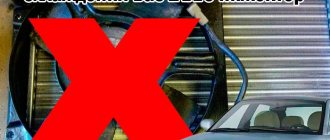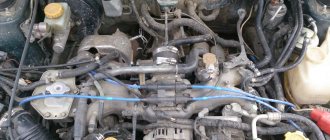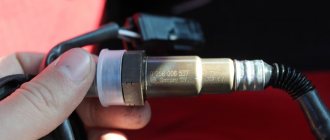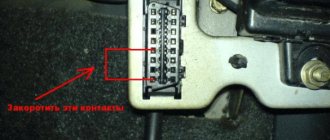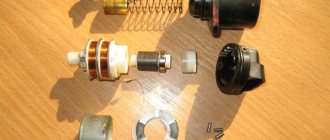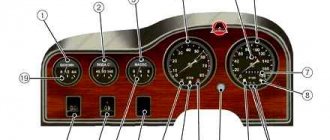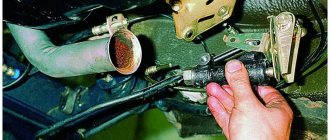In the life of motorists, a situation often arises when, when driving out onto the road and trying to accelerate, it is noted that the engine does not pull.
That is, the acceleration dynamics are very “sluggish”, the car is reluctant to pick up speed, and it feels like something is holding it back.
This problem can arise with almost any car - domestic or foreign, gasoline or diesel, with a carburetor power system and injector.
Often, a drop in traction is accompanied by additional symptoms - extraneous sounds appear when the engine is running, the engine may stall in one of the modes (usually at idle), the crankshaft speed is not stable and “floats”.
But this is not always the case; it happens that the unit behaves perfectly in all respects, but does not develop power.
The engine does not gain speed on a VAZ 2110
While operating their car, many drivers begin to notice that the engine does not gain speed properly. Accordingly, the dynamics decrease, the possibilities of maneuvering and overtaking are reduced. This problem cannot be tolerated.
Turnovers are not growing
Causes
There may be several reasons for the lack of proper speed gain:
- There are problems with the air supply;
- The ignition has failed;
- Fuel system malfunctions have occurred;
- There were problems with the exhaust system.
Fuel system problems are common in gasoline engines. They are the most common. Therefore, you should start with checking it.
Fuel system
If problems arise when accelerating the car, start checking by inspecting the fuel system.
- Most often, the engine stops gaining momentum because the fuel pump fails. At first, this may have a slight effect, sometimes unnoticed. Over time, as the pump wears out, the speed and power will begin to drop, and the acceleration dynamics will decrease.
- If the fuel pump is partially damaged, it still partially performs its functions, but is no longer capable of delivering the same volumes of fuel. This results in fuel starvation and power loss.
- The best solution to a problem with the pump is to replace it. It is better to trust repairs to specialists.
Ignition
If the ignition fails, you will have to conduct a comprehensive check of all system components that may cause a drop in engine power and speed.
Checking timing marks
If the marks are installed incorrectly, fuel will not be injected in a timely manner, and the correct frequency of spark supply will be disrupted.
You will have to check all the sensors that take part in the operation of the ignition system. Pay special attention to the crankshaft and camshaft position sensors. A regular test allows you to quickly determine whether the sensors are really to blame
If the belt has been in use on your vehicle for a long time, it may be at the end of its service life. Or it was installed incorrectly when replacing it. After all, it is enough to make a mistake by one tooth, and the performance of the car will be impaired, the car will not be able to accelerate properly
In some cases, they do not allow the car to start at all if there is a malfunction, but sometimes they lead to a noticeable drop in power. Remove them, check their condition, clean them, measure the distance between the electrodes. If they fail, simply replace them with new ones.
To finally verify the presence or absence of problems in the ignition system, it is recommended to conduct more detailed diagnostics.
Diagnostics
We suggest you familiarize yourself with several steps aimed at diagnosing the condition of the ignition system. This may help determine why the engine is not revving up.
- Make sure that the electronic control unit is performing its functions. First of all, turn on the ignition and listen to whether the fuel pump starts working.
- Measure the pressure in the fuel line. If the readings fall within 2.5-3.0 kg/cm3, then everything is fine.
- If the measurement readings are normal, check the BitStop parameter using scan tools while cranking the crankshaft. If the parameter is indicated “no”, then the ECU receives the command to create a spark at the plugs and works well.
- Using a high-voltage spark gap, you can check for the presence of a spark. After all, it’s not uncommon for worn-out, dirty spark plugs to be to blame.
Air supply
It is not uncommon for engine thrust to deteriorate due to a disruption in the normal air supply to create the air-fuel mixture.
If there is more air, the mixture will be lean because the amount of oxygen will exceed the amount of fuel. Hence the drop in power and decrease in traction.
The easiest way to solve an air supply problem is to replace the air filter. In order to prevent and prevent problems from occurring, this element should be changed twice a year.
Checking the mass air flow sensor
If the engine speed increases, but the speed does not increase, there are several possible explanations for this phenomenon:
- The pressure in the fuel system is too low;
- The operation of the mass air flow sensor is disrupted. The sensor most often returns to its previous performance after cleaning. If it doesn't help, replace it;
- The air filter is clogged. It is better to replace it;
- The nozzle is clogged. This is mainly due to the low quality of the fuel you fill your car with.
Material on topic:
— Checking the mass air flow sensor on a VAZ 2110 with your own hands
Exhaust system
Much less often, a drop in power and speed can be caused by problems with the exhaust system.
To make sure of this, check the condition of the catalyst for contamination or blockages.
It is the pollution that clogs the catalyst, which is why, despite all the possibilities, the car cannot squeeze out all the available power.
This is not to say that the VAZ 2110 has a very capricious engine. Although this largely depends on what kind of power unit is located under the hood of your “ten”. The first versions were not particularly reliable, but over time the engineers managed to make some progress.
Loading . No Comments Yet! You can be first to comment this post!
Loading, Please Wait!
Problems with the exhaust system
A rare cause of a drop in engine speed can be problems in the vehicle's exhaust system.
In order to verify this problem, it is necessary to diagnose the condition of the catalyst. It is necessary to identify the presence of dirt and blockages.
It is blockages and a large amount of dirt on the walls that can cause poor engine speed.
The engine does not pick up speed VAZ 2110 injector 8 valves. It's gaining momentum very poorly
1) Greetings, Happy New Year. car VAZ 2114, engine 1.6 8 valves. I don’t understand where to dig, it picks up speed very poorly, the slipper is on the floor, but it doesn’t react, then it picks up slowly, and you squeeze the clutch, it may either stall or it will idle at 520-630 revolutions and the sound is like the Cossacks, like a pot doesn't work, Jackie Chan doesn't burn. Tell me where to start digging Question from: @id1822769 Separate topic: 2) guys, such a story! VAZ 21074. The eight-wheel carburetor has an idle speed solenoid valve on it! So I decided to change it because the revolutions began to jump! a wire is connected to the solenoid valve, so that’s the rub, I remembered the valve, the speed also jumps, and now in addition to this, when the wire is disconnected from the valve, the car continues to work at very low speeds, but it works! ps before, when the wire was disconnected, the engine immediately stalled. Well, who can advise or help))) (I’ll tell you right away, I’ve already changed 3 of these valves, the result is the same) Question from: @id183726641 Separate topic: Write the number of the question you’re answering! To the authors of questions: be sure to write in the comments how you solved your problem! The engine does not pick up speed VAZ 2110 injector 8 valves.
Dips when pressing the gas pedal during acceleration
Determined using computer diagnostics or the steps described below:
- The first thing you need to do is inspect the spark plugs. To do this you need to remove them. The presence of carbon deposits on the spark plugs, poor contact with the wires, or an excessively lean or rich mixture lead to spark plug malfunctions.
- High voltage wires can also cause engine malfunction, as can ignition coils.
- The throttle needs to be checked. If it is clogged, this causes the engine to respond untimely when pressing the gas pedal.
- It is necessary to check the condition of the air, fuel and oil filters. They tend to get clogged, which worsens dynamics, increases fuel consumption and causes pedal failure. They need to be changed constantly, you can do it yourself, they are inexpensive and easy to install.
- The presence of errors in the ECU leads to failures.
- Clogged injectors. If necessary, replace or repair injectors.
The wires, as well as the rubber bands on them, should not be damaged and should not spark when the engine is running. If damage is found, this indicates that the engine is shaking and jerking begins. This may occur due to the age of the car, worn-out or low-quality spare parts, poor contact with the spark plugs, or due to the temperature of the engine.
The resistance of the coils and the temperature change together, as a result of which a gasoline car begins to jerk during acceleration. In diesel cars, jerking cannot be associated with the coils, since they are not present.
Why doesn't the engine rev up?
If the VAZ 2110 engine does not gain momentum, there may be several reasons.
- Fuel system malfunction.
- Faulty ignition.
- Air supply is obstructed.
- Exhaust problems.
This series of problems is typical for any car, so if the VAZ 2109 injection engine does not gain momentum, the reasons may be the same.
Problems in the fuel system are typical for gasoline engines and are the most common. In addition, this problem is also inherent in diesel engines.
Where to begin?
When you first have problems accelerating a car, you should start checking the car with the fuel system. The most common breakdown of a car's fuel system is the fuel pump, and it makes no difference whether it is mechanical or electrical. Both the first and the second are equally likely to fail at the most inopportune moment.
Difficulties with the pump may appear after a while. The car can slowly reduce its speed characteristics, and when this process reaches a noticeable state, you will understand why the engine does not gain speed.
The problem is the fuel pump, which, although it has not yet failed, is no longer actively supplying fuel to the engine. This inevitably leads to fuel starvation of the car, and, as a result, loss of power.
- You should start checking the ignition with the timing marks. It is the correctness of their installation that determines how timely fuel injection and spark supply will be.
- If the marks are in order, you should pay attention to the numerous sensors, which are plenty for an injection engine. You can check the crankshaft position sensors, camshaft position sensors and others yourself or entrust the car to a specialist.
- If everything is fine here, it’s worth paying attention to when the timing belt or chain was changed. The reason why your VAZ does not gain speed may be due to incorrect installation of the belt. Here it is enough to make a mistake by one tooth, and you can safely forget about normal acceleration of the car.
The 406 engine may not gain speed due to the fault of the injector, and the problem will be divided into two:
- the car won't start at all;
- the car does not work properly (this includes problems with speed, both while driving and idling, as well as all kinds of jerking of the car).
In the first case, the “nine” is often helped by warming up the battery or even recharging it. As you might guess, this situation occurs in winter during frosts. The reason lies in the decrease in battery capacity, which may simply not be enough to start the engine.
The second way to revive a frozen car is to supply hot air through a hair dryer. This “folk” method also helps many.
And finally, the third reason why a car may not start is faulty spark plugs.
Methods for diagnosing the problem
For the most accurate diagnosis, you will need to use a diagnostic tester, a fuel rail pressure gauge, a vacuum gauge and a spark gap.
- The first thing to check is whether the engine is controlled by the ECU. To do this, simply turn on the ignition and listen to whether the fuel pump makes noise.
- Then we look at the fuel line pressure. Data at the level of 2.5 - 3.0 kg/cubic centimeter are considered the norm.
- If these parameters are normal, you can check the BITSTOP parameter using the diagnostic tools while cranking the crankshaft. The BITSTOP parameter must be set to "no". This indicates that the ECU receives a command to start forming a spark on the spark plugs and is fully operational.
- By connecting a high-voltage spark gap, you can check whether there is a spark at all, and perhaps the cause is poor-quality spark plugs.
Also find out how much oil to fill in the engine and about flushing the engine before changing the oil.
Air supply
The air supply can also cause poor vehicle traction. If more air enters than it should, the composition of the fuel mixture will be disrupted. Those. there will be more air and less fuel, which will lead to a drop in thrust.
The simplest solution is to replace the air filter, which is recommended to be done every six months.
If the engine speed increases, but the speed does not gain, the reasons may be:
- low pressure in the fuel system (as mentioned earlier);
- problems in the operation of the mass air flow sensor;
- air filter clogged;
- coked nozzle.
It is more difficult to understand the operation of the mass flow sensor, since each car must have its own parameters, and you will still need the appropriate equipment. Even a deviation from the norm of 3 kg/hour can cause significant “changes” in engine operation, and not for the better. Using the 406 engine as an example, we can say that the norm is 13 - 15 kg/hour. At the same time, reducing the flow to 11 kg/hour will lead to such a problem that the engine does not gain speed or does so slowly, while increasing this figure to 19 kg/hour will significantly increase fuel consumption, and this is also unpleasant.
Coking of injectors is most often the result of low-quality fuel, since problems with the “electrical” part arise extremely rarely. To check, they often turn off the injectors one by one, while monitoring the drop in engine power. The norm is approximately 110 revolutions. However, such diagnostics are labor-intensive and will not give a 100% result, so all owners of injection systems, including 3sfe, are not recommended to clean their injectors every year. Who knows, maybe your 3sfe engine does not gain momentum for this very reason?
While driving
It is also an unpleasant situation when the car has jerks and dips during acceleration. This can happen both when driving and when starting off. A particularly unpleasant, or even dangerous, situation can arise while driving, for example, when a car is about to overtake, and then there is a sudden failure.
The causes of jerks during acceleration can be both those already mentioned and slightly different ones:
- If you have a carbureted car that jerks when accelerating, this may indicate that the ignition is too early. You need to set the lead angle. And checking the ignition timing is quite simple: at speed 4, accelerate to 50 km/h and brake sharply. If detonation lasts 1-2 seconds, then the ignition is set perfectly, the reason is not there;
- on “injectors” everything is controlled electronically. There, the jerking while driving and during acceleration may be due to the mixture being too lean. But this should be shown by diagnostics in the service. If the sensors “know about this, but are silent,” then it is quite possible that they themselves are faulty and must be replaced.
VAZ 2110 injector does not develop speed
It didn’t work well, it developed bad speed when you pressed the maximum speed.
VAZ 2109 floating speed.
We fix the problem with idle speed on the VAZ-2110 in 10 minutes.
Search results are developing.
Checking and replacing the VAZ 2110 fuel pressure regulator.
Removing the sensor from the car. VAZ 2114 panel wiring diagram.
The engine does not develop speed. (injector, Mazda_Last name) .
Why does the VAZ 2109 engine suffer from carburetor 267474450.
VAZ 2110 8 valve injector does not develop speed.
10. . all the injectors have come out of the holes in the engine intake pipe.
Idle speed of VAZ-2110. DIY car repair. auto repair
Idle speed sensor VAZ 2110 injector.
The 1.5-liter 8-valve injector received the VAZ-2111 engine index.
Despite its modest dimensions, this part can be removed if it malfunctions.
High fuel consumption - injector.
Very often, car enthusiasts are faced with the problem not of the repair itself, but of finding out.
VAZ 2109 eats a lot of gasoline.
When the idle speed fluctuates, it is quite difficult to operate the car.
Write a Comment
Click to cancel reply.
All about 2109
How to remove and clean the injectors on a VAZ 2109 (injector)?
Contents: Location When replacement is required Removal and
Reasons for engine overheating on a VAZ 2109 (carburetor, injector)
It's no secret that the engine is the main unit of the entire car. Your ability to drive a car, consume the optimal amount of fuel, and more depends on its performance. But overheating is a very common situation in which many people make serious mistakes.
Repair of the exhaust manifold on a VAZ 2109 (carburetor)
The exhaust manifold is a component of the exhaust system that carries out the process of removing exhaust gases from the cylinders of the power unit into the exhaust pipe.
Everyone has something happen to their car at some point. So my VAZ-2110 periodically has problems. What can I say, she’s already old.
My 10-wheeler began to show increased revs. It seems like I let off the gas, but the revs remain high. Then they gradually decrease. Or it idles, everything seems to be fine, and then suddenly the revs increase and increase on their own.
see also
“Peter - AT” INN 780703320484 OGRNIP 313784720500453
Up to 3 thousand revolutions it works like a clock, but after that it starts to jerk a lot! The fuel pump, armored lines and ignition unit are new! What could it be? (VAZ injection, 8 valve)
Comments 47
hose for the vacuum tank, how is it doing intact or with holes, look
good idea, thanks)
please ask the author of the topic to share with others how he solved the problem
so I shared it seems that 2 injectors were clogged, and since I was not there I don’t remember which ones (by count), they replaced the injectors and everything became fire)))
then sorry, I must have missed it
This also happened, it turned out that the fuel filter at the bottom was clogged, could not stand it and all the debris got into the injectors, at first it jerked, and then completely stalled. But after it started twitching, I drove another 300 km. Upon arrival home, I changed the filter, cleaned the tank and injectors and forgot about it.
replace the filter that is under the bottom of the car and drive on
How many people, so many opinions. Look at all engine systems one by one from simple to simple. If the check light does not light up, then it is unlikely to be a camshaft sensor, and it does not look like it. Also, if the crankshaft sensor doesn’t work, you won’t start the car. Look at the crankshaft pulley, it was somehow loose, just at speed it got into resonance and the DPKV could not get a normal signal from it. Relevant if you recently climbed into the timing belt. Check the air and pressure in the rail.
Look at the oxygen flow sensor)
Look at the crankshaft pulley, sometimes it even turns the crankshaft gear, look at the synchronization, it will show everything
+100. The key was cut off and the mark moved a little. That’s where the adjustment and lack of speed come from.
I have a piece of paper stuck to the filter in the tank... how the hell it got there, who knows. After 3.5t the car stalled while driving. at idle everything was ok
199% change the DMVR (Preferably BOSCH) in the air intake I had the same thing on a VAZ 21102, changed it and forgot.
Doesn't it stall if you raise the rpm to 4 thousand and hold it?
By the way, the same thing happened to me at ten. I cleaned the ramp and injectors at the same time. and the car flew off
go for diagnostics, what are you thinking... otherwise you will waste extra time, extra money on extra spare parts...
A new pump does not mean it is working, measure the pressure. The sensors most likely have nothing to do with it; they would work in emergency mode if they fail. what fuel system? with return? Look at the pressure reducing valve, and in general measure the pressure in the fuel rail.
Posts 6
1 Topic by max_fil 2016-10-15 15:34:14
- max_fil
- Participant
- Inactive
- Registration: 2013-04-30
- Messages: 42 Thanks : 12
- Car: VAZ 21103
Topic: Resolved: VAZ 2110 8 valves fails and has no traction
Hello Tazavod. I came across this problem. 2110 8 valve injector. Doesn't want to go. It is gaining momentum very poorly, one might say it is not gaining momentum at all. Big failures. Choke or whatever you can call it. I replaced all possible sensors (crankshaft, idle speed, throttle, cleaned injectors, changed spark plugs, armored wires, fuel pump mesh). Nothing helped. Such a strange thing was noticed, under load, in neutral everything seemed to be normal. When driving, when a failure occurs, you press the gas pedal to the floor, it seems to be trying to go, then slowly releasing the gas, it gains momentum. Where to go, what to look for? PS. I didn't measure the compression.
2 Reply from Sergey VAZ 2111 2016-10-15 18:08:09
- Sergey VAZ 2111
- Connoisseur
- Inactive
- Registration: 2013-11-21
- Messages: 513 Thanks : 145
- Car: VAZ 2111
Re: Resolved: VAZ 2110 8 valves have dips and no traction
If this problem suddenly arises, it means there is no compression. You need to check the fuel pressure in the rail. Either the fine filter is clogged, or the pump is tricky, or the check valve is tricky.
3 Reply from anton_lapin_90 2016-10-16 15:46:45
- anton_lapin_90
- New member
- Inactive
- From: Sukhinichi
- Registration: 2016-10-16
- Messages: 1 Thanks : 0
- Car: VAZ 2110 8kl.
Re: Resolved: VAZ 2110 8 valves have dips and no traction
First, compression - the main thing is to eliminate the mechanics, and then timing marks, spark, fuel pressure, etc.
4 Reply from artem3107 2016-10-16 19:33:05
- artem3107
- New member
- Inactive
- Registration: 2016-10-10
- Messages: 12 Thanks : 1
- Car: VAZ 21102
Re: Resolved: VAZ 2110 8 valves have dips and no traction
Hello Tazavod. I came across this problem. 2110 8 valve injector. Doesn't want to go. It is gaining momentum very poorly, one might say it is not gaining momentum at all. Big failures. Choke or whatever you can call it. I replaced all possible sensors (crankshaft, idle speed, throttle, cleaned injectors, changed spark plugs, armored wires, fuel pump mesh). Nothing helped. Such a strange thing was noticed, under load, in neutral everything seemed to be normal. When driving, when a failure occurs, you press the gas pedal to the floor, it seems to be trying to go, then slowly releasing the gas, it gains momentum. Where to go, what to look for? PS. I didn't measure the compression.
It looks like the fuel pressure regulator is faulty.
Or cutting off the pin.
Hello, Sergey. What does this have to do with the DPKV error? The ECU is not able to detect a rotated pulley. Error 335 can only appear if there is a malfunction of the sensor itself, its wires or the mass air flow sensor. This error also sometimes appears when jumping over a speed bump or other obstacle.
Or cutting off the pin.
Hello, Sergey. What does this have to do with the DPKV error? The ECU is not able to detect a rotated pulley. Error 335 can only appear if there is a malfunction of the sensor itself, its wires or the mass air flow sensor. This error also sometimes appears when jumping over a speed bump or other obstacle.
Many car enthusiasts are faced with the concept that the 16-valve VAZ-2112 does not gain momentum well. There may be several reasons for this phenomenon, so you need to know how to identify the malfunction, and most importantly, how to fix it.
Causes
There may be several reasons for the lack of proper speed gain:
- There are problems with the air supply;
- The ignition has failed;
- Fuel system malfunctions have occurred;
- There were problems with the exhaust system.
Fuel system problems are common in gasoline engines. They are the most common. Therefore, you should start with checking it.
Fuel system
If problems arise when accelerating the car, start checking by inspecting the fuel system.
- Most often, the engine stops gaining momentum because the fuel pump fails. At first, this may have a slight effect, sometimes unnoticed. Over time, as the pump wears out, the speed and power will begin to drop, and the acceleration dynamics will decrease.
- If the fuel pump is partially damaged, it still partially performs its functions, but is no longer capable of delivering the same volumes of fuel. This results in fuel starvation and power loss.
- The best solution to a problem with the pump is to replace it. It is better to trust repairs to specialists.
Ignition
If the ignition fails, you will have to conduct a comprehensive check of all system components that may cause a drop in engine power and speed.
What to check
Peculiarities
Checking timing marks
If the marks are installed incorrectly, fuel will not be injected in a timely manner, and the correct frequency of spark supply will be disrupted.
You will have to check all the sensors that take part in the operation of the ignition system. Pay special attention to the crankshaft and camshaft position sensors. A regular test allows you to quickly determine whether the sensors are really to blame
If the belt has been in use on your vehicle for a long time, it may be at the end of its service life. Or it was installed incorrectly when replacing it. After all, it is enough to make a mistake by one tooth, and the performance of the car will be impaired, the car will not be able to accelerate properly
In some cases, they do not allow the car to start at all if there is a malfunction, but sometimes they lead to a noticeable drop in power. Remove them, check their condition, clean them, measure the distance between the electrodes. If they fail, simply replace them with new ones.
To finally verify the presence or absence of problems in the ignition system, it is recommended to conduct more detailed diagnostics.
Faulty fuel supply system
One of the common reasons for poor engine speed may be the slow failure of the fuel pump. At first, this problem will not be very noticeable. But in the future the problem will become more and more noticeable. Because the pump will pump fuel into the engine worse and worse, which, in turn, will drop in speed.
The most rational solution to this problem may be to replace the fuel pump with a new one.
Dips when pressing the gas pedal - injector
To determine the reasons for the failure of the gas pedal of a raspberry with an injection engine, special equipment is needed, with the help of which diagnostics are carried out. Therefore, to detect a malfunction, you should definitely contact a car service in Moscow.
For the most part, jerking occurs when the fuel supply pressure is low or due to problems with the throttle position sensor.


